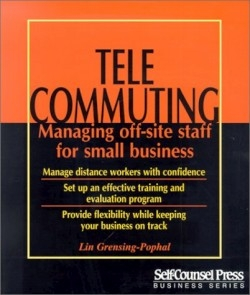Telecommuting
Managing Off-Site Staff for Small Business, Self-Counsel Business Series
Studies in 2001 by the Social Science Research Center at Old Dominion University reveal that a majority of teleworkers are satisfied with their experience to the extent that their loyalty to their company, whether large or small, is strong. The author presents a thorough, well-researched, and richly anecdotal book for all small- to medium-sized organizations that are considering allowing their employees the shortest commute to work: telecommuting.
Grensing-Pophal, a Wisconsin-based business journalist with Human Resource consulting experience in employee communication, training, and management issues, begins each of eight chapters with an executive summary that poses questions and gives short answers, which are then detailed in the chapter. A case study finalizes each chapter’s key points. Most chapters are complete with checklists, samples, forms, or some assessment tool to help a small business to improve and maintain the success of telecommuting for the company and the employee.
One question in the executive summary for Chapter Six, Training Telecommuters and Their Managers, is “Do managers need training?” After the brief “yes” in the summary, the author describes the characteristics and structure necessary for consideration, often referring to the approach used at Merrill Lynch: “At Merrill Lynch, as at most companies with effective telecommuting programs, this means formalized training. In many of these companies, training is broken down into three parts: telecommuter training, supervisor/manager training and ‘team training.’”
While telecommuting implies that technology is a central tool to use advantageously, it seems that organizations that succeed with telecommuting do so by focusing on the more critical issues of communication and interpersonal skills. Whether the chapter is about training, managing, policies, or recruiting and hiring the ideal worker, a key theme is the challenge for managers to shift to managing by results instead of by observation.
If a small business needs more employees but has limited space, if an employee wants to work from home, if a business owner wants to promote a flexible work environment without loss of creativity and productivity, then telecommuting may be the answer, and this book provides a complete resource and guide.
Reviewed by
Patricia Weber
Disclosure: This article is not an endorsement, but a review. The publisher of this book provided free copies of the book to have their book reviewed by a professional reviewer. No fee was paid by the publisher for this review. Foreword Reviews only recommends books that we love. Foreword Magazine, Inc. is disclosing this in accordance with the Federal Trade Commission’s 16 CFR, Part 255.

